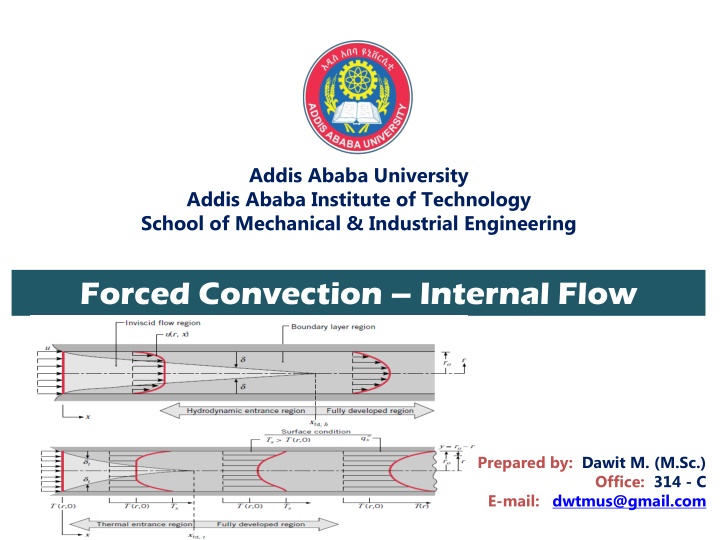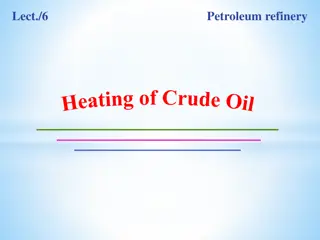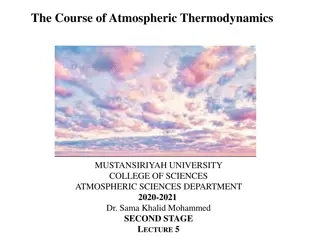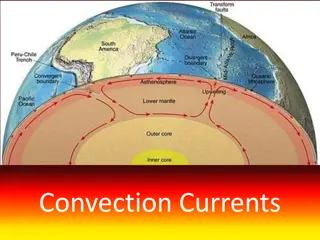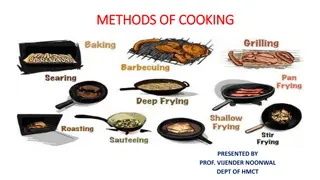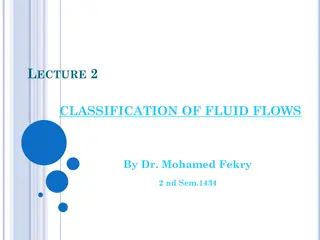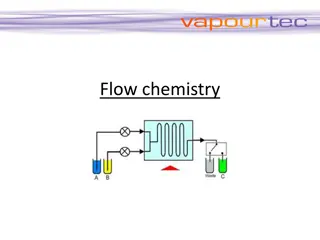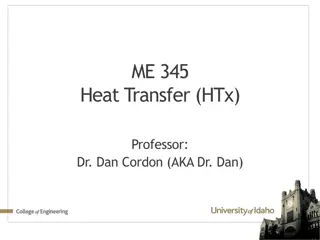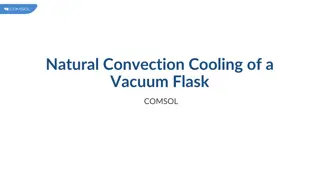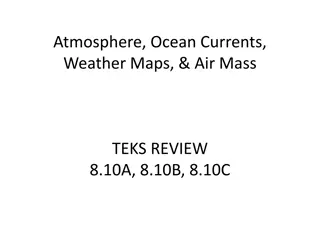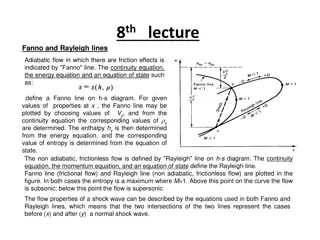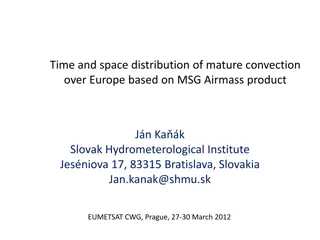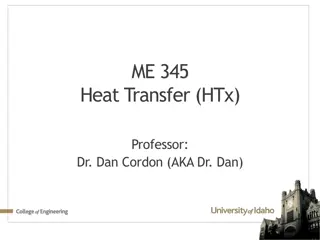Forced Convection – Internal Flow
This document delves into the principles of forced convection internal flow in mechanical engineering, covering hydrodynamic and thermal considerations, empirical correlations, and practical applications. It explores the unique features of boundary layer development, energy balances, and convection coefficients for internal flow conditions. The content provides insights for students and professionals in the field.
Download Presentation

Please find below an Image/Link to download the presentation.
The content on the website is provided AS IS for your information and personal use only. It may not be sold, licensed, or shared on other websites without obtaining consent from the author.If you encounter any issues during the download, it is possible that the publisher has removed the file from their server.
You are allowed to download the files provided on this website for personal or commercial use, subject to the condition that they are used lawfully. All files are the property of their respective owners.
The content on the website is provided AS IS for your information and personal use only. It may not be sold, licensed, or shared on other websites without obtaining consent from the author.
E N D
Presentation Transcript
Addis Ababa University Addis Ababa Institute of Technology School of Mechanical & Industrial Engineering Forced Convection Internal Flow Prepared by: Dawit M. (M.Sc.) Office: 314 - C E-mail: dwtmus@gmail.com
Outline o Introduction o Objectives o Hydrodynamic Considerations o Thermal Considerations o Empirical Convection Correlations Internal Flow o Examples 2 AAiT School of Mechanical and Industrial Engineering - SMiE
Introduction Recall that an external flow is one for which boundary layer development on a surface is allowed to continue without external constraints, as for the flat plate. In contrast, an internal flow, such as flow in a pipe, is one for which the fluid is confined by a surface. Hence the boundary layer is unable to develop without eventually being constrained. The internal flow configuration represents a convenient geometry for heating and cooling fluids used in chemical processing, environmental control, and energy conversion technologies. 3 AAiT School of Mechanical and Industrial Engineering - SMiE
Objectives After completion of this lecture and tutorial on internal flow forced convection students will be able to: Consider velocity (hydrodynamic) and Thermal effects pertinent to internal flows, focusing on certain unique features of boundary layer development. Apply overall energy balance to determine fluid temperature variations in the flow direction. Develop an appreciation for the physical phenomena associated with internal flow and to obtain convection coefficients for flow conditions of practical importance. (Correlations for estimating the convection heat transfer coefficient are presented for a variety of internal flow conditions.) 4 AAiT School of Mechanical and Industrial Engineering - SMiE
Hydrodynamic Considerations When considering external flow, it is necessary to ask only whether the flow is laminar or turbulent. However, for an internal flow we must also be concerned with the existence of entrance and fully developed regions. Flow Conditions: Where Umis the mean fluid velocity over the cross section and D is the diameter. Critical Reynod s number to the onset of turbulence is: 5 AAiT School of Mechanical and Industrial Engineering - SMiE
Contd Laminar Flow For laminar flow (ReD 2300), the hydrodynamic entry length may be obtained from an expression of the form: This expression is based on the presumption that fluid enters the tube from a rounded converging nozzle and is hence characterized by a nearly uniform velocity profile at the entrance. Turbulent Flow Although there is no satisfactory general expression for the entry length in turbulent flow, we know that it is approximately independent of Reynolds number and that, as a first approximation: For the purposes of this text, we shall assume fully developed turbulent flow for: (x/D) > 10 6 AAiT School of Mechanical and Industrial Engineering - SMiE
Contd The Mean Velocity For steady, incompressible flow in a tube of uniform cross-sectional area, The Velocity Profile in the Fully Developed Region The form of the velocity profile may readily be determined for the laminar flow of an incompressible, constant property fluid in the fully developed region of a circular tube. 7 AAiT School of Mechanical and Industrial Engineering - SMiE
Contd The Pressure Drop The engineer is frequently interested in the pressure drop needed to sustain an internal flow because this parameter determines pump or fan power requirements. Friction factor (f) for Fully Developed Laminar Flow: Friction factor (f) for Fully Developed Turbulent Flow: For fully developed turbulent flow, the analysis is much more complicated; and we must ultimately rely on experimental results. Friction factors for a wide Reynolds number range are presented in the Moody diagram. In addition to depending on the Reynolds number, the friction factor is a function of the tube surface condition, e. 8 AAiT School of Mechanical and Industrial Engineering - SMiE
Contd Correlations that reasonably approximate the smooth surface condition are of the form: Alternatively, a single correlation that encompasses a large Reynolds number range has been developed by Petukhov and is of the form: The Pressure Drop ( P): The Pump or Fan Power Requirement: Where the volumetric flow rate an incompressible fluid. may, in turn, be expressed as for 9 AAiT School of Mechanical and Industrial Engineering - SMiE
Contd Moody Chart 10 AAiT School of Mechanical and Industrial Engineering - SMiE
Thermal Considerations The shape of the fully developed temperature profile T(r,x) differs according to whether a uniform surface temperature or heat flux is maintained. For both surface conditions, however, the amount by which fluid temperatures exceed the entrance temperature increases with increasing x. For laminar flow the thermal entry length may be expressed as: Note: if Pr >1, the hydrodynamic boundary layer develops more rapidly than the thermal boundary layer (xfd,h< xfd,t), while the inverse is true for Pr < 1. For extremely large Prandtl number fluids, such as oils (Pr > 100), xfd,his very much smaller than xfd,tand it is reasonable to assume a fully developed velocity profile throughout the thermal entry region. AAiT School of Mechanical and Industrial Engineering - SMiE 11
Contd In contrast, for turbulent flow, conditions are nearly independent of Prandtl number, and to a first approximation, we shall assume: (xfd,t/D) = 10 The Mean Temperature Just as the absence of a free stream velocity requires use of a mean velocity to describe an internal flow, the absence of a fixed free stream temperature necessitates using a mean (or bulk) temperature. Newton s Law of Cooling Where h is the local convection heat transfer coefficient. However, there is an essential difference between Tmand T. Whereas T is constant in the flow direction, Tmmust vary in this direction. That is, dTm/dx is never zero if heat transfer is occurring. The value of Tmincreases with x if heat transfer is from the surface to the fluid (Ts> Tm); it decreases with x if the opposite is true (Ts< Tm). 12 AAiT School of Mechanical and Industrial Engineering - SMiE
Contd Note: Hence in the thermally fully developed flow of a fluid with constant properties, the local convection coefficient is a constant, independent of x. In the entrance region, where h varies with x, as shown in Figure. Because the thermal boundary layer thickness is zero at the tube entrance, the convection coefficient is extremely large at x = 0. However, h decays rapidly as the thermal boundary layer develops, until the constant value associated with fully developed conditions is reached 13 AAiT School of Mechanical and Industrial Engineering - SMiE
Contd Fully Developed Conditions One might legitimately conditions can ever be reached. The situation is certainly different from the hydrodynamic case, for which (?u/?x) = 0 in the fully developed region. In contrast, if there is heat transfer, (dTm/dx), as well as (?T/?x) at any radius r, is not zero. Accordingly, the temperature profile T(r) is continuously changing with x, and it would seem that a fully developed condition could never be reached. This apparent contradiction may be reconciled by working with a dimensionless form of the temperature. question whether fully developed thermal Requirement: Although the temperature profile T(r) continues to change with x, the relative shape of the profile no longer changes and the flow is: 14 AAiT School of Mechanical and Industrial Engineering - SMiE
Contd The condition given by the equation above is eventually reached in a tube for which there is either a uniform surface heat flux (q is constant) or a uniform surface temperature (Tsis constant). Note that it is impossible to simultaneously impose the conditions of constant surface heat flux and constant surface temperature. If q is constant, Tsmust vary with x; conversely, if Tsis constant, q must vary with x. The Energy Balance Because the flow in a tube is completely enclosed, an energy balance may be applied to determine how the mean temperature Tm(x) varies with position along the tube and how the total convection heat transfer qconvis related to the difference in temperatures at the tube inlet and outlet. 15 AAiT School of Mechanical and Industrial Engineering - SMiE
Contd The solution to the above equation for Tm(x) depends on the surface thermal condition. Recall that the two special cases of interest are constant surface heat flux and constant surface temperature. 16 AAiT School of Mechanical and Industrial Engineering - SMiE
Contd Case Constant Surface Heat Flux 17 AAiT School of Mechanical and Industrial Engineering - SMiE
Contd Case Constant Surface Temperature Let T = Ts- Tm 18 AAiT School of Mechanical and Industrial Engineering - SMiE
Contd It is readily shown that the results of this section may still be used if Tsis replaced by T (the free stream temperature of the external fluid) and h (avg.) is replaced by (the average overall heat transfer coefficient). For such cases, it follows that: 19 AAiT School of Mechanical and Industrial Engineering - SMiE
Empirical Convection Correlations Internal Flow Laminar Flow in Circular Tubes: Convection Correlations The Fully Developed Region: Hence in a circular tube characterized by uniform surface heat flux and laminar, fully developed conditions, the Nusselt number is a constant, independent of ReD, Pr, and axial location. The thermal conductivity should be evaluated at Tm. The Entry Region: 20 AAiT School of Mechanical and Industrial Engineering - SMiE
Contd For the constant surface temperature condition, it is desirable to know the average convection coefficient, presents a correlation attributed to Hausen, which is of the form: Because this result is for the thermal entry length problem, it is applicable to all situations where the velocity profile is already fully developed. For the combined entry length, a suitable correlation for use at moderate Prandtl numbers, due to Sieder and Tate 21 AAiT School of Mechanical and Industrial Engineering - SMiE
Contd Convection Correlations: Turbulent Flow in Circular Tubes From the Chilton Colburn: The Dittus Boelter equation: 22 AAiT School of Mechanical and Industrial Engineering - SMiE
Contd The above correlations are used to a good approximation for both the uniform surface temperature and heat flux conditions. For fully developed turbulent flow in smooth circular tubes with constant surface heat flux, Skupinski et al. recommend a correlation of the form: 23 AAiT School of Mechanical and Industrial Engineering - SMiE
Contd Convection Correlations: Noncircular Tubes 24 AAiT School of Mechanical and Industrial Engineering - SMiE
Contd Convection Correlations: Concentric Tube Annulus 25 AAiT School of Mechanical and Industrial Engineering - SMiE
Contd 26 AAiT School of Mechanical and Industrial Engineering - SMiE
Example 1 1. Water is to be heated from 15 C to 65 C as it flows through a 3-cm- internal-diameter 5-m-long tube. The tube is equipped with an electric resistance heater that provides uniform heating throughout the surface of the tube. The outer surface of the heater is well insulated, so that in steady operation all the heat generated in the heater is transferred to the water in the tube. If the system is to provide hot water at a rate of 10 L/min, determine the power rating of the resistance heater. Also, estimate the inner surface temperature of the pipe at the exit. 27 AAiT School of Mechanical and Industrial Engineering - SMiE
Example 2 2. Hot air at atmospheric pressure and 80 C enters an 8 m-long uninsulated square duct of cross section 0.2 m x 0.2 m that passes through the attic of a house at a rate of 0.15 m3/s. The duct is observed to be nearly isothermal at 60 C. Determine the exit temperature of the air and the rate of heat loss from the duct to the attic space. 28 AAiT School of Mechanical and Industrial Engineering - SMiE
Thank You Questions are Welcomed!
